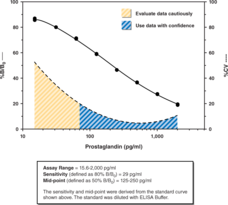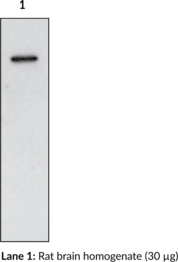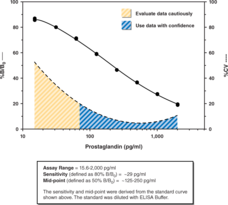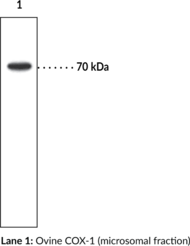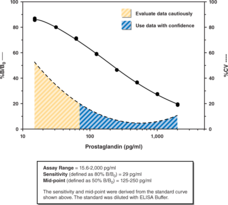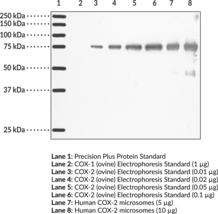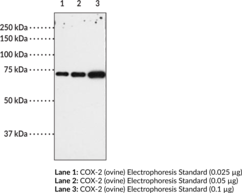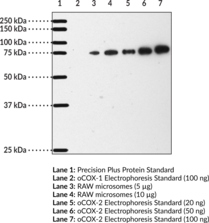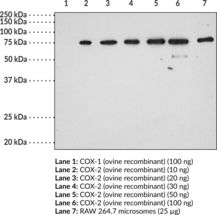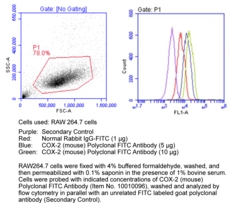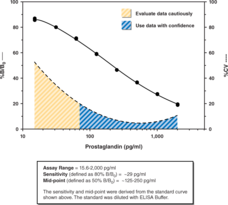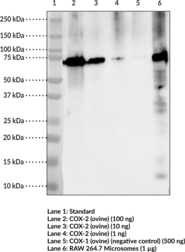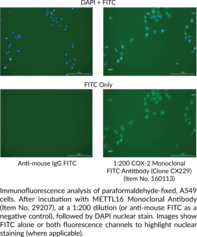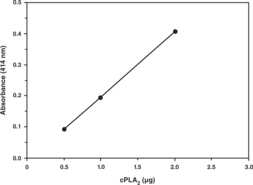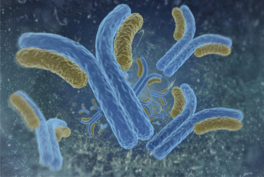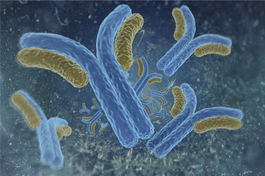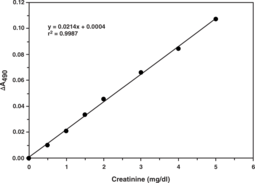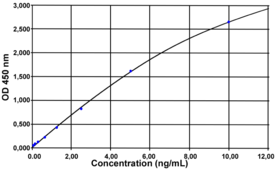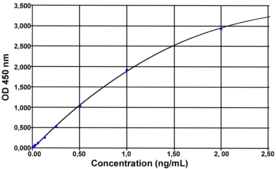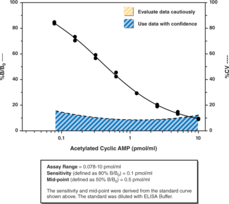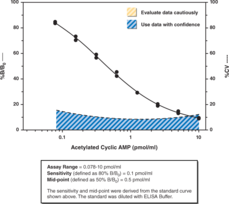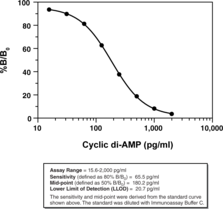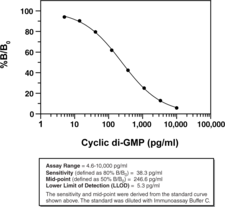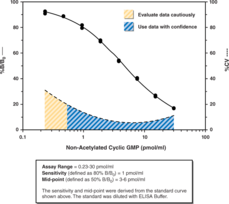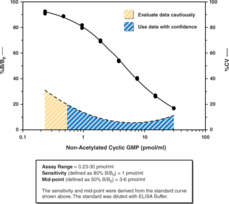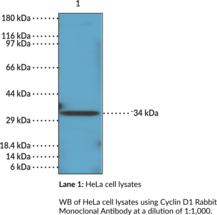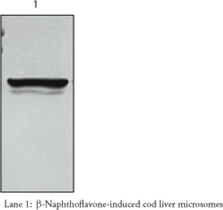ELISA Kits
Showing 451–600 of 3623 results
-
Cyclooxygenase (COX, also called Prostaglandin H Synthase or PGHS) is a bifunctional enzyme exhibiting both COX and peroxidase activities. The COX component converts arachidonic acid to a hydroperoxy endoperoxide (PGG2), and the peroxidase component reduces the endoperoxide to the corresponding alcohol (PGH2), the precursor of PGs, thromboxanes, and prostacyclins.{500,501} It is now well established that there are two distinct isoforms of COX, COX-1 and COX-2. Cayman’s COX Fluorescent Inhibitor Screening Assay provides a convenient fluorescence-based method for screening ovine COX-1 and human recombinant COX-2 for isozyme-specific inhibitors. The assay utilizes the peroxidase component of COXs. In this assay, the reaction between PGG2 and ADHP (10-acetyl-3,7-dihydroxyphenoxazine) produces the highly fluorescent compound resorufin. Resorufin fluorescence can be analyzed with an excitation wavelength of 530-540 nm and an emission wavelength of 585-595 nm.
Brand:CaymanSKU:700100 - 2 x 96 wellsAvailable on backorder
Brand:CaymanSKU:460103 - 1 eaAvailable on backorder
Brand:CaymanSKU:460102 - 1 eaAvailable on backorder
Brand:CaymanSKU:460106 - 1 eaAvailable on backorder
Brand:CaymanSKU:460105 - 1 eaAvailable on backorder
Brand:CaymanSKU:460104 - 1 eaAvailable on backorder
Brand:CaymanSKU:460107 - 1 eaAvailable on backorder
Cyclooxygenase catalyzes the first step in the biosynthesis of prostaglandins, thromboxanes, and prostacyclins: the conversion of arachidonic acid to prostaglandin H2 COX-1 is constitutively expressed in almost all animal tissues and is involved in the homeostatic role of eicosanoids.{14,767} Recent discoveries of the induction of cyclooxygenase biosynthesis by a variety of stimuli such as phorbol esters, lipopolysaccharides, and cytokines led to the hypothesis that the inducible form of cyclooxygenase, COX-2, is responsible for the biosynthesis of prostaglandins under acute inflammatory conditions.{4} COX-1 and -2 are 70 and 72 kDa proteins, respectively. Both cyclooxygenases have been cloned from a variety of species including human, mouse, rat, and sheep.{13,4051} COX-1 isoform at the amino acid level, whereas the homology between COX-1 and COX-2 is only about 60%.
Brand:CaymanSKU:160103 - 500 µlAvailable on backorder
Cyclooxygenase (COX, also called Prostaglandin H Synthase or PGHS) is a bifunctional enzyme that converts arachidonic acid to a hydroperoxy endoperoxide (PGG2) and reduces the endoperoxide to the corresponding alcohol (PGH2), the precursor of prostaglandins, thromboxanes, and prostacyclins. COX-1 is constitutively expressed in a variety of cell types and is involved in normal cellular homeostasis. The COX-1 (human) Inhibitor Screening Assay directly measures PGF2α by SnCl2 reduction of COX-derived PGH2 produced in the COX reaction. The prostanoid product is quantified via enzyme immunoassay using a broadly specific antiserum that binds to all the major prostaglandin compounds. This assay includes human recombinant COX-1 allowing the user to screen specific inhibitors. This assay is an excellent tool that can be used for general inhibitor screening, or to eliminate false positive leads generated by less specific methods.
Brand:CaymanSKU:701070 - 96 wellsAvailable on backorder
COX-1 is responsible for the production of prostaglandins essential for the normal function of many organs including the stomach and kidney.{3463} COX-1 is generally described as being constitutively expressed, although COX-1 expression is regulated developmentally and in response to a variety of other stimuli.{6608,13,1508,12} Mouse COX-1 has a molecular weight of 70,000 and is expressed in nearly all tissues of the body.{3463,300}
Brand:CaymanSKU:160109 - 1 eaAvailable on backorder
COX-1 and COX-2 catalyze the production of the prostaglandin (PG) and thromboxane precursor PGH2. COX-2 is primarily responsible for the biosynthesis of PGs under acute inflammatory conditions. The COX-1 (ovine) Inhibitor Screening Assay measures PGF2α that is produced by SnCl2 reduction of COX-1-derived PGH2. PGF2α is quantified via enzyme immunoassay (EIA) using a broadly specific antiserum that binds to all the major PG compounds. This assay includes ovine COX-1 and is an excellent tool which can be used for general inhibitor screening, or to eliminate false positive leads generated by less specific methods.
Brand:CaymanSKU:701090 - 96 wellsAvailable on backorder
COX-1 is responsible for the production of prostaglandins essential for the normal function of many organs including stomach and kidney.{3463} Although COX-1 is generally described as constitutively expressed, this is actually an oversimplification. COX-1 expression is regulated developmentally and in response to a variety of other stimuli.{6608,13,1508,12} COX-1 has a molecular weight of 70 kDa and is expressed in nearly all tissues of the body.{3463,13,300,919}
Brand:CaymanSKU:160110 - 1 eaAvailable on backorder
This product is derived by labeling the COX-1 monoclonal antibody (Item No. 160110) with fluorescein. COX-1 catalyzes the first step in the biosynthesis of prostaglandins, thromboxanes, and prostacyclins: the conversion of arachidonic acid to prostaglandin H2. COX-1 is constitutively expressed in almost all animal tissues and is involved in the homeostatic role of eicosanoids.{14,767} COX-1 is a 70 kDa protein which has been cloned from a variety of species including human, mouse, rat, and sheep.{13,300,5695,919} COX-1 from these species are approximately 90% identical at the amino acid level, whereas the homology between COX-1 and COX-2 is only about 60%.
Brand:CaymanSKU:160111 - 250 µgAvailable on backorder
This product is derived by labeling the COX-1 monoclonal antibody (Item No. 160110) with phycoerythrin. COX-1 is responsible for the production of prostaglandins essential for the normal function of many organs including stomach and kidney.{3463} Although COX-1 is generally described as constitutively expressed, this is actually an oversimplification. COX-1 expression is regulated developmentally and in response to a variety of other stimuli.{6608,13,1508,12} COX-1 has a molecular weight of 70,000 and is expressed in nearly all tissues of the body.{3463,13,300,919}
Brand:CaymanSKU:160120 - 1 eaAvailable on backorder
COX-1 and COX-2 catalyze the production of the prostaglandin (PG) and thromboxane precursor PGH2. COX-2 is primarily responsible for the biosynthesis of PGs under acute inflammatory conditions. The COX-2 (human recombinant) Inhibitor Screening Assay measures PGF2α that is produced by SnCl2 reduction of COX-2-derived PGH2. PGF2α is quantified via enzyme immunoassay (EIA) using a broadly specific antiserum that binds to all the major PG compounds. This assay includes human recombinant COX-2 and is an excellent tool which can be used for general inhibitor screening, or to eliminate false positive leads generated by less specific methods.
Brand:CaymanSKU:701080 - 96 wellsAvailable on backorder
Cyclooxygenase 2 (COX-2) is a bifunctional enzyme that exhibits both COX and peroxidase activities and catalyzes the first step in the biosynthesis of prostaglandins, thromboxanes, and prostacyclins.{500,501} The COX component converts arachidonic acid to the hydroperoxy endoperoxide prostaglandin G2 (PGG2; Item No. 17010), and the peroxidase component reduces the endoperoxide to the corresponding alcohol PGH2 (Item No. 17020). COX2 expression is induced by a variety of stimuli, including phorbol esters, LPS, and cytokines and is responsible for the biosynthesis of PGs under acute inflammatory conditions.{54420,14766} Thus, COX-2 has been the focus of attention for nonsteroidal anti-inflammatory drug (NSAID) development. Cayman’s COX-2 (human) Monoclonal Antibody (Clone CX229) can be used for immunohistochemistry (IHC) and Western blot (WB) applications. The antibody recognizes a unique C-terminal region of COX-2 that is not present in COX-1, specifically detecting COX-2 ~70 kDa from human and ovine samples.
Brand:CaymanSKU:160112 - 1 eaAvailable on backorder
COX-2 has been cloned from a variety of species including human, rat, and sheep and has a molecular weight of 72 kDa.{2,7,2884,4051}, COX-2 from these species are approximately 90% identical at the amino acid level, whereas the homology between COX-1 and COX-2 is only about 60%. Expression of COX-2 is regulated by growth factors, tumor promoters, bacterial endotoxin and cytokines, including IL-1β.{1528,1887} COX-2 is present in human breast tumors but is not expressed in normal breast tissue.{4154}
Brand:CaymanSKU:160107 - 1 eaAvailable on backorder
COX catalyzes the first step in the biosynthesis of prostaglandins, thromboxanes, and prostacyclins: the conversion of arachidonic acid to prostaglandin H2. Recent discoveries of the induction of COX by a variety of stimuli such as phorbol esters, lipopolysaccharides, and cytokines led to the hypothosis that the inducible form of COX, COX-2, is responsible for the biosynthesis of prostaglandins under acute inflammatory conditions.{4,3463} COX-2 is a 72 kDa protein which has been cloned from a variety of species including human, mouse, rat, and sheep.{2,7,2284,4051}
Brand:CaymanSKU:160106 - 1 eaAvailable on backorder
Cyclooxygenase (COX) catalyzes the first step in the biosynthesis of prostaglandins (PGs), thromboxanes, and prostacyclins: the conversion of arachidonic acid to PGH2. Recent discoveries of the induction of COX by a variety of stimuli such as phorbol esters, lipopolysaccharides, and cytokines led to the hypothesis that the inducible form of COX, COX-2, is responsible for the biosynthesis of PGs under acute inflammatory conditions.{4,3463} COX-2 is a 72 kDa protein which has been cloned from a variety of species including human, mouse, rat, and sheep.{2,7,2884,4051}
Brand:CaymanSKU:160126 - 1 eaAvailable on backorder
The primary use of this antibody conjugate is for the detection of cyclooxygenase 2 (COX-2) in mouse samples by direct immunolabeling. COX catalyze the first step in the biosynthesis of prostaglandins (PGs), thromboxanes, and prostacyclins: the conversion of arachidonic acid to PGH2. Discoveries of the induction of COX by a variety of stimuli such as phorbol esters, lipopolysaccharides, and cytokines led to the hypothosis that the inducible form of COX, COX-2, is responsible for the biosynthesis of PGs under acute inflammatory conditions.{4,3463} COX-2 is a 72 kDa protein which has been cloned from a variety of species including human, mouse, rat, and sheep.{2,7,2284,4051}
Brand:CaymanSKU:10010096 - 1 eaAvailable on backorder
COX-1 and COX-2 catalyze the production of the prostaglandin (PG), thromboxane, and prostacyclin precursor PGH2. COX-2 is responsible for the biosynthesis of PGs under acute inflammatory conditions. This inducible COX-2 is believed to be the target enzyme for the anti-inflammatory activity of nonsteroidal anti-inflammatory drugs. The COX-2 (ovine) Inhibitor Screening Assay directly measures PGF2α (Item No. 16010) by SnCl2 reduction of COX-2-derived PGH2 (Item No. 17020) produced in the COX-2 reaction. The prostanoid product is quantified via enzyme immunoassay (EIA) using a broadly specific antiserum that binds to all the major PG compounds. This assay includes ovine COX-2 allowing the user to screen specific inhibitors. This assay is an excellent tool that can be used for general inhibitor screening, or to eliminate false positive leads generated by less specific methods.
Brand:CaymanSKU:702000 - 96 wellsAvailable on backorder
Cyclooxygenase catalyzes the first step in the biosynthesis of prostaglandins, thromboxanes, and prostacyclins: the conversion of arachidonic acid to prostaglandin H2. Recent discoveries of the induction of cyclooxygenase biosynthesis by a variety of stimuli such as phorbol esters, lipopolysaccharides, and cytokines led to the hypothesis that the inducible form of cyclooxygenase, COX-2, is responsible for the biosynthesis of prostaglandins under acute inflammatory conditions.{4} Cayman’s COX-2 monoclonal antibody (clone 12C10) can be used for ELISA, flow cytometry, immunofluorescence, and Western blot applications. The antibody recognizes COX-2 at 72 kDa from human, mouse, and ovine samples.
Brand:CaymanSKU:20198 - 50 µgAvailable on backorder
This product is derived by labeling the COX-2 monoclonal antibody (Item No. 160112) with fluorescein.
Brand:CaymanSKU:160113 - 1 eaAvailable on backorder
Brand:CaymanSKU:765030 - 1 eaAvailable on backorder
Phospholipase A2 catalyzes the hydrolysis of fatty acids at the sn-2 position of glycerophospholipids, yielding a free fatty acid and a lysophospholipid as products.{2489} The release of arachidonic acid from membrane phospholipids by these enzymes is believed to be the key step in the biosynthesis of eicosanoids.{1474} There are primarily three different kinds of phospholipase A2. They are secretory (sPLA2), calcium-dependent cytosolic (cPLA2), and calcium-independent cytosolic (iPLA2) phospholipase A2. Of these three different types of enzymes, only the cPLA2 exhibits specificity towards arachidonic acid whereas all others can hydrolyze any fatty acid at the sn-2 position. Arachidonoyl Thio-PC is a substrate for cPLA2 by virtue of the presence of arachidonic acid at the sn-2 position of the glycerophospholipid.{1357} Hydrolysis of the arachidonoyl thioester bond at the sn-2 position by PLA2 releases a free thiol which can be detected by DTNB (5,5′-dithio-bis-(2-nitrobenzoic acid)). This assay can be used to determine the activity of cPLA2 in purified preparations, cell cultures, or tissue homogenates that are known to contain only cPLA2. Use of this assay with preparations containing more than one type of PLA2 will result in the measurement of total PLA2 activity rather than cPLA2 alone. Isozyme-specific cPLA2 activity can be measured by excluding sPLA2 or inhibiting iPLA2 activities in the assay. Each kit contains cPLA2 assay buffer, DTNB/EGTA, Arachidonoyl Thio-PC (substrate), bee venom PLA2 (control), bromoenol lactone solution, a 96 well plate, and complete instructions.
Brand:CaymanSKU:765021 - 96 wellsAvailable on backorder
Cellular retinoic acid-binding protein 1 is a protein that in humans is encoded by the CRABP1 gene. A number of specific carrier proteins for members of the vitamin A family have been discovered. CRABP is assumed to play an important role in retinoic acid-mediated differentiation and proliferation processes. CRABP1 is structurally similar to the cellular retinol-binding proteins, but binds only retinoic acid, and constitutively expressed. It is thought to play an important role in retinoic acid-mediated differentiation and proliferation processes. In addition, Crabp1 protects cells from excess RA by binding it in the cytosol, away from RARs. [Bertin Catalog No. G01002]
Brand:CaymanSKU:32760 - 100 µlAvailable on backorder
The vitamin A metabolite retinoic acid (RA) regulates gene transcription by activating several members of the nuclear receptor family of ligand-activated transcription factors: the classical RA receptors RARα, RARβ, and RARγ and the peroxisome proliferator-activated receptor β/δ (PPARβ/δ). The partitioning of the hormone between its receptors is regulated by two intracellular lipid-binding proteins, cellular retinoic acid-binding protein type II (CRABP-II), which delivers RA to RAR, and fatty acid-binding protein type 5 (FABP5), which shuttles it to PPARβ/δ. [Bertin Catalog No. G01003]
Brand:CaymanSKU:32761 - 100 µlAvailable on backorder
The vitamin A metabolite retinoic acid (RA) regulates gene transcription by activating several members of the nuclear receptor family of ligand-activated transcription factors: the classical RA receptors RARα, RARβ, and RARγ and the peroxisome proliferator-activated receptor β/δ (PPARβ/δ). The partitioning of the hormone between its receptors is regulated by two intracellular lipid-binding proteins, cellular retinoic acid-binding protein type II (CRABP-II), which delivers RA to RAR, and fatty acid-binding protein type 5 (FABP5), which shuttles it to PPARβ/δ. [Bertin Catalog No. G01004]
Brand:CaymanSKU:32762 - 100 µlAvailable on backorder
Creatinine is commonly measured in urine and is a key benchmark for the normalization of a variety of urinary biomarkers. Serum creatinine levels, however, are a useful indicator of renal function. In addition, abnormal creatinine levels have been implicated in diabetes, cardiovascular, and circulatory diseases. Cayman’s Creatinine (serum) Assay is designed to measure creatinine levels in plasma and serum. The assay relies on the Jaffe’ reaction, wherein a yellow/orange color forms when the metabolite is treated with alkaline picrate. The rate of color development is directly proportional to the concentration of creatinine in the sample and is measured at an absorbance between 490-500 nm. The kinetic nature of the assay eliminates interference from extraneous serum contaminants, such as lipids and bilirubin.
Brand:CaymanSKU:700460 - 2 x 96 wellsAvailable on backorder
Creatine is synthesized in kidney, liver, and pancreas and transported to muscle and brain where it is phosphorylated to phosphocreatine. Some free creatine in muscle is converted to creatinine. The amount of creatinine produced is proportional to an individual’s muscle mass. In the absence of renal disease, the excretion rate of creatinine in an individual is relatively constant. Thus, urinary creatinine levels are commonly used as an index of standardization for a variety of other tests. Measurement of creatinine clearance is also useful in detecting renal disease and estimating the extent of impairment of renal function.
Brand:CaymanSKU:500701 - 480 wellsAvailable on backorder
Creatine is synthesized in kidney, liver, and pancreas and transported to muscle and brain where it is phosphorylated to phosphocreatine. Some free creatine in muscle is converted to creatinine. The amount of creatinine produced is proportional to an individual’s muscle mass. In the absence of renal disease, the excretion rate of creatinine in an individual is relatively constant. Thus, urinary creatinine levels are commonly used as an index of standardization for a variety of other tests. Measurement of creatinine clearance is also useful in detecting renal disease and estimating the extent of impairment of renal function.
Brand:CaymanSKU:500701 - 96 wellsAvailable on backorder
It is well known that the control of gene expression involves activation of protein kinase cascades that regulate transcription factors within the nucleus.{14339} The cyclic AMP response element binding protein (CREB) is one of the best characterized stimulus-induced transcription factors.{14341} This transcription factor is a component of intracellular signaling events that regulate a wide range of biological functions, from spermatogenesis to circadian rhythms and memory.{14342,14343} A variety of protein kinases including protein kinase A (PKA), mitogen-activated protein kinases (MAPKs), and Ca2+/calmodulin-dependent protein kinases (CaMKs) phosphorylate CREB at serine 133 (Ser133), and phosphorylation of Ser133 is required for CREB-mediated transcription.{14338,14340}
Brand:CaymanSKU:10009181 - 1 eaAvailable on backorder
CREB (cAMP-response-element-binding protein) is a transcription factor that binds to cAMP-responsive element (CRE) promoter sites to regulate the transcription of numerous genes involved in metabolic regulation, depression, long term memory, and other physiological processes. Phosphorylation on serine 133 (Ser133) activates CREB to induce transcription of target genes. Diverse stimuli such as growth factors, neurotransmitters, hypoxia, growth factors, UV light, survival signals, and stress signals are some of the known activators of CREB. The signaling systems and mechanisms involved in CREB activation continue to be of interest in academic research and drug discovery programs. Cayman’s CREB (Phospho-Ser133) Transcription Factor Assay is a non-radioactive, sensitive method for detecting CREB DNA binding activity. CREB contained in a nuclear extract or whole cell lysate binds specifically to the DNA cAMP response element immobilized to the wells a 96-well plate. The activated CREB transcription factor complex is detected by addition of a specific primary antibody directed against Phospho-Ser133 on CREB. A secondary antibody conjugated to HRP is used to provide a sensitive colorimetric readout at 450 nm.
Brand:CaymanSKU:10009846 - 96 wellsAvailable on backorder
Prostaglandin D2 (PGD2) elicits its biological function through interaction with two distinct G protein-coupled receptors, DP1 and CRTH2/DP2. CRTH2 primarily couples to Gi or Gq subunits to mobilize Ca2+, induce cell migration, and up-regulate adhesion molecules.{11493} CRTH2 mRNA has been detected in various tissues including liver, lung, kidney, brain, heart, thymus, and spleen and in various cell lineages including both hematopoietic and non-hematopoietic cell lines.{9767} Human CRTH2 is 395 amino acids in length with an estimated molecular weight of 43 kDa. Cayman’s CRTH2/DP2 receptor (C-Term) polyclonal antibody can be used for western blot of CRTH2 on samples of human, mouse, and rat origin. It detects both unglycosylated and glycosylated protein at sizes ranging from 35-40 to 50-70 kDa, as reported by Nagata et al., in 1999.{9770}
Brand:CaymanSKU:10007002 - 1 eaAvailable on backorder
Prostaglandin D2 (PGD2) elicits its biological function through interaction with two distinct G protein-coupled receptors, DP1 and CRTH2/DP2. CRTH2 primarily couples to Gi or Gq subunits to mobilize Ca2+, induce cell migration, and up-regulate adhesion molecules.{11493} CRTH2 mRNA has been detected in various tissues including liver, lung, kidney, brain, heart, thymus, and spleen and in various cell lineages including both hematopoietic and non-hematopoietic cell lines.{9767} Human CRTH2 is 395 amino acids in length with an estimated molecular weight of 43 kDa. Cayman’s CRTH2/DP2 Receptor (N-Term) Polyclonal Antibody can be used for western blot of CRTH2 on samples of human, mouse, and rat origin. It detects both unglycosylated and glycosylated protein at sizes ranging from 35-40 to 50-70 kDa, as reported by Nagata et al., in 1999.{9770}
Brand:CaymanSKU:10004886 - 1 eaAvailable on backorder
Superoxide dismutase (SOD) is an endogenously produced intracellular enzyme present in almost every cell in the body.{15491} It works by catalyzing the dismutation of the superoxide radical O2- to O2 and H2O2, which are then metabolized to H2O and O2 by catalase and glutathione peroxidase.{15490,15493} In general, SODs play a major role in antioxidant defense mechanisms.{15492} There are two main types of SOD in mammalian cells. One form, SOD1, contains Cu and Zn ions as a homodimer and exists in the cytoplasm. The two subunits of 16 kDa each are linked by two cystines forming an intra-subunit disulphide bridge.{15491} The second form, SOD2, is a manganese-containing enzyme and resides in the mitochondrial matrix. It is a homotetramer of 80 kDa. The third form, SOD3 or EC-SOD, is like SOD1 in that it contains Cu and Zn ions, however it is distinct in that it is a homotetramer, with a mass of 30 kDa and it exists only in the extra-cellular space.{15494} SOD3 can also be distinguished by its heparin-binding capacity.{15489}
Brand:CaymanSKU:10011388 - 100 µlAvailable on backorder
Superoxide dismutase (SOD) is an endogenously produced intracellular enzyme present in almost every cell in the body.{15491} It works by catalyzing the dismutation of the superoxide radical O2- to O2 and H2O2, which are then metabolized to H2O and O2 by catalase and glutathione peroxidase.{15490,15493} In general, SODs play a major role in antioxidant defense mechanisms.{15492} There are two main types of SOD in mammalian cells. One form, SOD1, contains Cu and Zn ions as a homodimer and exists in the cytoplasm. The two subunits of 16 kDa each are linked by two cystines forming an intra-subunit disulphide bridge.{15491} The second form, SOD2, is a manganese-containing enzyme and resides in the mitochondrial matrix. It is a homotetramer of 80 kDa. The third form, SOD3 or EC-SOD, is like SOD1 in that it contains Cu and Zn ions, however it is distinct in that it is a homotetramer, with a mass of 30 kDa and it exists only in the extra-cellular space.{15494} SOD3 can also be distinguished by its heparin-binding capacity.{15489}
Brand:CaymanSKU:10011388 - 25 µlAvailable on backorder
Superoxide dismutase (SOD) is an endogenously produced intracellular enzyme present in almost every cell in the body.{15491} It works by catalyzing the dismutation of the superoxide radical O2- to O2 and H2O2, which are then metabolized to H2O and O2 by catalase and glutathione peroxidase.{15490,15493} In general, SODs play a major role in antioxidant defense mechanisms.{15492} There are two main types of SOD in mammalian cells. One form, SOD1, contains Cu and Zn ions as a homodimer and exists in the cytoplasm. The two subunits of 16 kDa each are linked by two cystines forming an intra-subunit disulphide bridge.{15491} The second form, SOD2, is a manganese containing enzyme and resides in the mitochondrial matrix. It is a homotetramer of 80 kDa. The third form, SOD3 or EC-SOD, is like SOD1 in that it contains Cu and Zn ions, however it is distinct in that it is a homotetramer, with a mass of 30 kDa and it exists only in the extra-cellular space.{15494} SOD3 can also be distinguished by its heparin-binding capacity.{15489}
Brand:CaymanSKU:10011387 - 100 µlAvailable on backorder
Superoxide dismutase (SOD) is an endogenously produced intracellular enzyme present in almost every cell in the body.{15491} It works by catalyzing the dismutation of the superoxide radical O2- to O2 and H2O2, which are then metabolized to H2O and O2 by catalase and glutathione peroxidase.{15490,15493} In general, SODs play a major role in antioxidant defense mechanisms.{15492} There are two main types of SOD in mammalian cells. One form, SOD1, contains Cu and Zn ions as a homodimer and exists in the cytoplasm. The two subunits of 16 kDa each are linked by two cystines forming an intra-subunit disulphide bridge.{15491} The second form, SOD2, is a manganese containing enzyme and resides in the mitochondrial matrix. It is a homotetramer of 80 kDa. The third form, SOD3 or EC-SOD, is like SOD1 in that it contains Cu and Zn ions, however it is distinct in that it is a homotetramer, with a mass of 30 kDa and it exists only in the extra-cellular space.{15494} SOD3 can also be distinguished by its heparin-binding capacity.{15489}
Brand:CaymanSKU:10011387 - 25 µlAvailable on backorder
CXCL10 is also known as interferon-γ-induced protein 10 (IP-10) or small-inducible cytokine B10 with a molecular weight close to 10 kDa. CXCL10 is expressed by several cellular types like monocytes, endothelial cells and fibroblasts stimulated by the interferon-γ (INF-γ). The receptor of this chemokine is CXCR3 that is shared with CXCL9 and CXCL11. CXCL10 plays an important role in the recruitment of the immune cells to sites of inflammation. It is included in physiological process like bone marrow colony formation and angiogenesis but also in some disorders like Th1-type human inflammatory diseases, or cancer. [Bertin Catalog No. A05419]
Brand:CaymanSKU:23623 - 96 wellsAvailable on backorder
CXCL9 is a small cytokine belonging to the CXC chemokine family that is also known as Monokine induced by gamma interferon (MIG). It is secreted by various cell types including immune cells (T lymphocytes, NK cells, macrophages), and non-immune cells (fibroblasts, keratinocytes, endothelial cells). The main factor of production is the interferon-gamma in Th1-type immune responses. CXCR3 has been identified as the receptor of CXCL9. The main function of CXCL9 is the recruitment of immune cells on the inflammation site. [Bertin Catalog No. A05418]
Brand:CaymanSKU:23622 - 96 wellsAvailable on backorder
Brand:CaymanSKU:481002 - 100 dtnAvailable on backorder
Brand:CaymanSKU:481002 - 500 dtnAvailable on backorder
Cayman’s cAMP assay is a very sensitive competitive ELISA that permits cAMP measurements within the standard curve range of 0.078-10 pmol/ml, typically with a sensitivity (80% B/B0) of 0.1 pmol/ml once samples and standards have been acetylated prior to analysis. This assay has been validated with culture media, urine, tissue, and plasma samples. If you prefer to assay your samples and still achieve excellent sensitivity without the need to perform a pre-assay acetylation step we recommend using Cayman’s cAMP Select ELISA Kit. Cyclic AMP is a ubiquitous cellular second messenger that is a critical component of a signal transduction pathway linking membrane receptors and their ligands to the activation of internal cellular enzymatic activity and gene expression. cAMP is synthesized from ATP by membrane-bound adenylate cyclase. Binding of certain ligands or hormones to their specific G-protein couple receptors activates GTP binding proteins (Gs or Gi) which either stimulate or inhibit adenylate cyclase. cAMP activates or inhibits various enzymes or cascade of enzymes by promoting their phosphorylation or dephosphorylation. The cAMP signal is neutralized by hydrolysis of cAMP to AMP by phosphodiesterases. Therefore, the concentration of cAMP in a cell is a function of the ratio of the rate of synthesis from ATP by adenylate cyclase and its rate of breakdown to AMP by specific phosphodiesterases.
Brand:CaymanSKU:581001 - 480 solid wellsAvailable on backorder
Cayman’s cAMP assay is a very sensitive competitive ELISA that permits cAMP measurements within the standard curve range of 0.078-10 pmol/ml, typically with a sensitivity (80% B/B0) of 0.1 pmol/ml once samples and standards have been acetylated prior to analysis. This assay has been validated with culture media, urine, tissue, and plasma samples. If you prefer to assay your samples and still achieve excellent sensitivity without the need to perform a pre-assay acetylation step we recommend using Cayman’s cAMP Select ELISA Kit. Cyclic AMP is a ubiquitous cellular second messenger that is a critical component of a signal transduction pathway linking membrane receptors and their ligands to the activation of internal cellular enzymatic activity and gene expression. cAMP is synthesized from ATP by membrane-bound adenylate cyclase. Binding of certain ligands or hormones to their specific G-protein couple receptors activates GTP binding proteins (Gs or Gi) which either stimulate or inhibit adenylate cyclase. cAMP activates or inhibits various enzymes or cascade of enzymes by promoting their phosphorylation or dephosphorylation. The cAMP signal is neutralized by hydrolysis of cAMP to AMP by phosphodiesterases. Therefore, the concentration of cAMP in a cell is a function of the ratio of the rate of synthesis from ATP by adenylate cyclase and its rate of breakdown to AMP by specific phosphodiesterases.
Brand:CaymanSKU:581001 - 480 strip wellsAvailable on backorder
Cayman’s cAMP assay is a very sensitive competitive ELISA that permits cAMP measurements within the standard curve range of 0.078-10 pmol/ml, typically with a sensitivity (80% B/B0) of 0.1 pmol/ml once samples and standards have been acetylated prior to analysis. This assay has been validated with culture media, urine, tissue, and plasma samples. If you prefer to assay your samples and still achieve excellent sensitivity without the need to perform a pre-assay acetylation step we recommend using Cayman’s cAMP Select ELISA Kit. Cyclic AMP is a ubiquitous cellular second messenger that is a critical component of a signal transduction pathway linking membrane receptors and their ligands to the activation of internal cellular enzymatic activity and gene expression. cAMP is synthesized from ATP by membrane-bound adenylate cyclase. Binding of certain ligands or hormones to their specific G-protein couple receptors activates GTP binding proteins (Gs or Gi) which either stimulate or inhibit adenylate cyclase. cAMP activates or inhibits various enzymes or cascade of enzymes by promoting their phosphorylation or dephosphorylation. The cAMP signal is neutralized by hydrolysis of cAMP to AMP by phosphodiesterases. Therefore, the concentration of cAMP in a cell is a function of the ratio of the rate of synthesis from ATP by adenylate cyclase and its rate of breakdown to AMP by specific phosphodiesterases.
Brand:CaymanSKU:581001 - 96 solid wellsAvailable on backorder
Cayman’s cAMP assay is a very sensitive competitive ELISA that permits cAMP measurements within the standard curve range of 0.078-10 pmol/ml, typically with a sensitivity (80% B/B0) of 0.1 pmol/ml once samples and standards have been acetylated prior to analysis. This assay has been validated with culture media, urine, tissue, and plasma samples. If you prefer to assay your samples and still achieve excellent sensitivity without the need to perform a pre-assay acetylation step we recommend using Cayman’s cAMP Select ELISA Kit. Cyclic AMP is a ubiquitous cellular second messenger that is a critical component of a signal transduction pathway linking membrane receptors and their ligands to the activation of internal cellular enzymatic activity and gene expression. cAMP is synthesized from ATP by membrane-bound adenylate cyclase. Binding of certain ligands or hormones to their specific G-protein couple receptors activates GTP binding proteins (Gs or Gi) which either stimulate or inhibit adenylate cyclase. cAMP activates or inhibits various enzymes or cascade of enzymes by promoting their phosphorylation or dephosphorylation. The cAMP signal is neutralized by hydrolysis of cAMP to AMP by phosphodiesterases. Therefore, the concentration of cAMP in a cell is a function of the ratio of the rate of synthesis from ATP by adenylate cyclase and its rate of breakdown to AMP by specific phosphodiesterases.
Brand:CaymanSKU:581001 - 96 strip wellsAvailable on backorder
Cayman’s cAMP assay is a very sensitive competitive ELISA that permits cAMP measurements within the standard curve range of 0.078-10 pmol/ml, typically with a sensitivity (80% B/B0) of 0.1 pmol/ml once samples and standards have been acetylated prior to analysis. This assay has been validated with culture media, urine, tissue, and plasma samples. If you prefer to assay your samples and still achieve excellent sensitivity without the need to perform a pre-assay acetylation step we recommend using Cayman’s cAMP Select ELISA Kit. Cyclic AMP is a ubiquitous cellular second messenger that is a critical component of a signal transduction pathway linking membrane receptors and their ligands to the activation of internal cellular enzymatic activity and gene expression. cAMP is synthesized from ATP by membrane-bound adenylate cyclase. Binding of certain ligands or hormones to their specific G-protein couple receptors activates GTP binding proteins (Gs or Gi) which either stimulate or inhibit adenylate cyclase. cAMP activates or inhibits various enzymes or cascade of enzymes by promoting their phosphorylation or dephosphorylation. The cAMP signal is neutralized by hydrolysis of cAMP to AMP by phosphodiesterases. Therefore, the concentration of cAMP in a cell is a function of the ratio of the rate of synthesis from ATP by adenylate cyclase and its rate of breakdown to AMP by specific phosphodiesterases.
Brand:CaymanSKU:581002 - 480 solid wellsAvailable on backorder
Cayman’s cAMP assay is a very sensitive competitive ELISA that permits cAMP measurements within the standard curve range of 0.078-10 pmol/ml, typically with a sensitivity (80% B/B0) of 0.1 pmol/ml once samples and standards have been acetylated prior to analysis. This assay has been validated with culture media, urine, tissue, and plasma samples. If you prefer to assay your samples and still achieve excellent sensitivity without the need to perform a pre-assay acetylation step we recommend using Cayman’s cAMP Select ELISA Kit. Cyclic AMP is a ubiquitous cellular second messenger that is a critical component of a signal transduction pathway linking membrane receptors and their ligands to the activation of internal cellular enzymatic activity and gene expression. cAMP is synthesized from ATP by membrane-bound adenylate cyclase. Binding of certain ligands or hormones to their specific G-protein couple receptors activates GTP binding proteins (Gs or Gi) which either stimulate or inhibit adenylate cyclase. cAMP activates or inhibits various enzymes or cascade of enzymes by promoting their phosphorylation or dephosphorylation. The cAMP signal is neutralized by hydrolysis of cAMP to AMP by phosphodiesterases. Therefore, the concentration of cAMP in a cell is a function of the ratio of the rate of synthesis from ATP by adenylate cyclase and its rate of breakdown to AMP by specific phosphodiesterases.
Brand:CaymanSKU:581002 - 480 strip wellsAvailable on backorder
Cayman’s cAMP assay is a very sensitive competitive ELISA that permits cAMP measurements within the standard curve range of 0.078-10 pmol/ml, typically with a sensitivity (80% B/B0) of 0.1 pmol/ml once samples and standards have been acetylated prior to analysis. This assay has been validated with culture media, urine, tissue, and plasma samples. If you prefer to assay your samples and still achieve excellent sensitivity without the need to perform a pre-assay acetylation step we recommend using Cayman’s cAMP Select ELISA Kit. Cyclic AMP is a ubiquitous cellular second messenger that is a critical component of a signal transduction pathway linking membrane receptors and their ligands to the activation of internal cellular enzymatic activity and gene expression. cAMP is synthesized from ATP by membrane-bound adenylate cyclase. Binding of certain ligands or hormones to their specific G-protein couple receptors activates GTP binding proteins (Gs or Gi) which either stimulate or inhibit adenylate cyclase. cAMP activates or inhibits various enzymes or cascade of enzymes by promoting their phosphorylation or dephosphorylation. The cAMP signal is neutralized by hydrolysis of cAMP to AMP by phosphodiesterases. Therefore, the concentration of cAMP in a cell is a function of the ratio of the rate of synthesis from ATP by adenylate cyclase and its rate of breakdown to AMP by specific phosphodiesterases.
Brand:CaymanSKU:581002 - 96 solid wellsAvailable on backorder
Cayman’s cAMP assay is a very sensitive competitive ELISA that permits cAMP measurements within the standard curve range of 0.078-10 pmol/ml, typically with a sensitivity (80% B/B0) of 0.1 pmol/ml once samples and standards have been acetylated prior to analysis. This assay has been validated with culture media, urine, tissue, and plasma samples. If you prefer to assay your samples and still achieve excellent sensitivity without the need to perform a pre-assay acetylation step we recommend using Cayman’s cAMP Select ELISA Kit. Cyclic AMP is a ubiquitous cellular second messenger that is a critical component of a signal transduction pathway linking membrane receptors and their ligands to the activation of internal cellular enzymatic activity and gene expression. cAMP is synthesized from ATP by membrane-bound adenylate cyclase. Binding of certain ligands or hormones to their specific G-protein couple receptors activates GTP binding proteins (Gs or Gi) which either stimulate or inhibit adenylate cyclase. cAMP activates or inhibits various enzymes or cascade of enzymes by promoting their phosphorylation or dephosphorylation. The cAMP signal is neutralized by hydrolysis of cAMP to AMP by phosphodiesterases. Therefore, the concentration of cAMP in a cell is a function of the ratio of the rate of synthesis from ATP by adenylate cyclase and its rate of breakdown to AMP by specific phosphodiesterases.
Brand:CaymanSKU:581002 - 96 strip wellsAvailable on backorder
Brand:CaymanSKU:481004 - 1 eaAvailable on backorder
Brand:CaymanSKU:401042 - 100 dtnAvailable on backorder
Brand:CaymanSKU:401042 - 500 dtnAvailable on backorder
Cayman’s cAMP Select assay is a competitive ELISA that permits cAMP measurements within the standard curve range of 0.09-200 pmol/ml and a sensitivity (80% B/B0) of approximately 0.6 pmol/ml. Acetylation of samples is not required in this highly sensitive assay where culture media, urine, tissue, and plasma samples have been validated. Cyclic AMP is a ubiquitous cellular second messenger that is a critical component of a signal transduction pathway linking membrane receptors and their ligands to the activation of internal cellular enzymatic activity and gene expression. cAMP is synthesized from ATP by membrane-bound adenylate cyclase. Binding of certain ligands or hormones to their specific G-protein couple receptors activates GTP binding proteins (Gs or Gi) which either stimulate or inhibit adenylate cyclase. cAMP activates or inhibits various enzymes or cascade of enzymes by promoting their phosphorylation or dephosphorylation. The cAMP signal is neutralized by hydrolysis of cAMP to AMP by phosphodiesterases. Therefore, the concentration of cAMP in a cell is a function of the ratio of the rate of synthesis from ATP by adenylate cyclase and its rate of breakdown to AMP by specific phosphodiesterases.
Brand:CaymanSKU:501040 - 480 solid wellsAvailable on backorder
Cayman’s cAMP Select assay is a competitive ELISA that permits cAMP measurements within the standard curve range of 0.09-200 pmol/ml and a sensitivity (80% B/B0) of approximately 0.6 pmol/ml. Acetylation of samples is not required in this highly sensitive assay where culture media, urine, tissue, and plasma samples have been validated. Cyclic AMP is a ubiquitous cellular second messenger that is a critical component of a signal transduction pathway linking membrane receptors and their ligands to the activation of internal cellular enzymatic activity and gene expression. cAMP is synthesized from ATP by membrane-bound adenylate cyclase. Binding of certain ligands or hormones to their specific G-protein couple receptors activates GTP binding proteins (Gs or Gi) which either stimulate or inhibit adenylate cyclase. cAMP activates or inhibits various enzymes or cascade of enzymes by promoting their phosphorylation or dephosphorylation. The cAMP signal is neutralized by hydrolysis of cAMP to AMP by phosphodiesterases. Therefore, the concentration of cAMP in a cell is a function of the ratio of the rate of synthesis from ATP by adenylate cyclase and its rate of breakdown to AMP by specific phosphodiesterases.
Brand:CaymanSKU:501040 - 480 strip wellsAvailable on backorder
Cayman’s cAMP Select assay is a competitive ELISA that permits cAMP measurements within the standard curve range of 0.09-200 pmol/ml and a sensitivity (80% B/B0) of approximately 0.6 pmol/ml. Acetylation of samples is not required in this highly sensitive assay where culture media, urine, tissue, and plasma samples have been validated. Cyclic AMP is a ubiquitous cellular second messenger that is a critical component of a signal transduction pathway linking membrane receptors and their ligands to the activation of internal cellular enzymatic activity and gene expression. cAMP is synthesized from ATP by membrane-bound adenylate cyclase. Binding of certain ligands or hormones to their specific G-protein couple receptors activates GTP binding proteins (Gs or Gi) which either stimulate or inhibit adenylate cyclase. cAMP activates or inhibits various enzymes or cascade of enzymes by promoting their phosphorylation or dephosphorylation. The cAMP signal is neutralized by hydrolysis of cAMP to AMP by phosphodiesterases. Therefore, the concentration of cAMP in a cell is a function of the ratio of the rate of synthesis from ATP by adenylate cyclase and its rate of breakdown to AMP by specific phosphodiesterases.
Brand:CaymanSKU:501040 - 96 solid wellsAvailable on backorder
Cayman’s cAMP Select assay is a competitive ELISA that permits cAMP measurements within the standard curve range of 0.09-200 pmol/ml and a sensitivity (80% B/B0) of approximately 0.6 pmol/ml. Acetylation of samples is not required in this highly sensitive assay where culture media, urine, tissue, and plasma samples have been validated. Cyclic AMP is a ubiquitous cellular second messenger that is a critical component of a signal transduction pathway linking membrane receptors and their ligands to the activation of internal cellular enzymatic activity and gene expression. cAMP is synthesized from ATP by membrane-bound adenylate cyclase. Binding of certain ligands or hormones to their specific G-protein couple receptors activates GTP binding proteins (Gs or Gi) which either stimulate or inhibit adenylate cyclase. cAMP activates or inhibits various enzymes or cascade of enzymes by promoting their phosphorylation or dephosphorylation. The cAMP signal is neutralized by hydrolysis of cAMP to AMP by phosphodiesterases. Therefore, the concentration of cAMP in a cell is a function of the ratio of the rate of synthesis from ATP by adenylate cyclase and its rate of breakdown to AMP by specific phosphodiesterases.
Brand:CaymanSKU:501040 - 96 strip wellsAvailable on backorder
Brand:CaymanSKU:401044 - 2000 pmolAvailable on backorder
Cayman’s Cyclic di-AMP ELISA Kit is a competitive assay that can be used for quantification of cyclic di-AMP in bacterial cell lysates. The assay has a range of 15.6-2,000 pg/ml with a midpoint of approximately 180 pg/ml (50% B/B0) and a sensitivity (80% B/B0) of approximately 66 pg/ml. Powered by BIOLOG Life Science Institute.
Brand:CaymanSKU:501960 - 96 solid wellsAvailable on backorder
Cayman’s Cyclic di-AMP ELISA Kit is a competitive assay that can be used for quantification of cyclic di-AMP in bacterial cell lysates. The assay has a range of 15.6-2,000 pg/ml with a midpoint of approximately 180 pg/ml (50% B/B0) and a sensitivity (80% B/B0) of approximately 66 pg/ml. Powered by BIOLOG Life Science Institute.
Brand:CaymanSKU:501960 - 96 strip wellsAvailable on backorder
Cyclic di-AMP ELISA Standard has been tested and formulated to work exclusively with Cayman’s Cyclic di-AMP ELISA Kit (Item No. 501960). Please visit Cyclic di-AMP ELISA Kit (Item No. 501960) for the kit protocol, procedures, and product handling.
Brand:CaymanSKU:401964 - 15 ngAvailable on backorder
Cayman’s Cyclic di-GMP ELISA Kit is a competitive assay that can be used for quantification of cyclic di-GMP in bacterial cell lysates. The assay has a range of 4.6-10,000 pg/ml with a midpoint of approximately 250 pg/ml (50% B/B0) and a sensitivity (80% B/B0) of approximately 38 pg/ml. Powered by BIOLOG Life Science Institute.
Brand:CaymanSKU:501780 - 96 solid wellsAvailable on backorder
Cayman’s Cyclic di-GMP ELISA Kit is a competitive assay that can be used for quantification of cyclic di-GMP in bacterial cell lysates. The assay has a range of 4.6-10,000 pg/ml with a midpoint of approximately 250 pg/ml (50% B/B0) and a sensitivity (80% B/B0) of approximately 38 pg/ml. Powered by BIOLOG Life Science Institute.
Brand:CaymanSKU:501780 - 96 strip wellsAvailable on backorder
Cyclic di-GMP ELISA Monoclonal Antibody has been tested and formulated to work exclusively with Cayman’s Cyclic di-GMP ELISA Kit (Item No. 501780). Please visit Cyclic di-GMP ELISA Kit (Item No. 501780) for the kit protocol, procedures, and product handling.
Brand:CaymanSKU:401782 - 100 dtnAvailable on backorder
Brand:CaymanSKU:401784 - 100 ngAvailable on backorder
Brand:CaymanSKU:481022 - 100 dtnAvailable on backorder
Brand:CaymanSKU:481022 - 500 dtnAvailable on backorder
The Cayman Chemical cGMP Assay is a competitive ELISA that can be used for quantification of cGMP directly obtained from cell lysates, tissue homogenates, plasma, or urine. The assay has a range from 0.23-30 pmol/ml and a sensitivity (80% B/B0) of approximately 1 pmol/ml. Since the antibody used in this assay was prepared against a cGMP-carrier protein conjugate, antibody binding is increased if an acetyl group is present on the 2′ hydroxyl group of the cGMP. The optional acetylation procedure for both samples and standards increases the sensitivity of the assay approximately 10 fold. A protocol for acetylating both the standards and samples prior to performing the assay is provided. Basal levels of cGMP in cell lysates can often be measured without acetylation, but results will depend on the type and number of cells being utilized. Platelets produce approximately 1.5-2.5 pmol cGMP/109 platelets under basal conditions.{5912,668,4218} Cells such as NG108-15 cells and monocytes produce considerably more cGMP than platelets (approximately 0.1-1 pmol/106 cells).{3743,1825}
Brand:CaymanSKU:581021 - 480 solid wellsAvailable on backorder
The Cayman Chemical cGMP Assay is a competitive ELISA that can be used for quantification of cGMP directly obtained from cell lysates, tissue homogenates, plasma, or urine. The assay has a range from 0.23-30 pmol/ml and a sensitivity (80% B/B0) of approximately 1 pmol/ml. Since the antibody used in this assay was prepared against a cGMP-carrier protein conjugate, antibody binding is increased if an acetyl group is present on the 2′ hydroxyl group of the cGMP. The optional acetylation procedure for both samples and standards increases the sensitivity of the assay approximately 10 fold. A protocol for acetylating both the standards and samples prior to performing the assay is provided. Basal levels of cGMP in cell lysates can often be measured without acetylation, but results will depend on the type and number of cells being utilized. Platelets produce approximately 1.5-2.5 pmol cGMP/109 platelets under basal conditions.{5912,668,4218} Cells such as NG108-15 cells and monocytes produce considerably more cGMP than platelets (approximately 0.1-1 pmol/106 cells).{3743,1825}
Brand:CaymanSKU:581021 - 480 strip wellsAvailable on backorder
The Cayman Chemical cGMP Assay is a competitive ELISA that can be used for quantification of cGMP directly obtained from cell lysates, tissue homogenates, plasma, or urine. The assay has a range from 0.23-30 pmol/ml and a sensitivity (80% B/B0) of approximately 1 pmol/ml. Since the antibody used in this assay was prepared against a cGMP-carrier protein conjugate, antibody binding is increased if an acetyl group is present on the 2′ hydroxyl group of the cGMP. The optional acetylation procedure for both samples and standards increases the sensitivity of the assay approximately 10 fold. A protocol for acetylating both the standards and samples prior to performing the assay is provided. Basal levels of cGMP in cell lysates can often be measured without acetylation, but results will depend on the type and number of cells being utilized. Platelets produce approximately 1.5-2.5 pmol cGMP/109 platelets under basal conditions.{5912,668,4218} Cells such as NG108-15 cells and monocytes produce considerably more cGMP than platelets (approximately 0.1-1 pmol/106 cells).{3743,1825}
Brand:CaymanSKU:581021 - 96 solid wellsAvailable on backorder
The Cayman Chemical cGMP Assay is a competitive ELISA that can be used for quantification of cGMP directly obtained from cell lysates, tissue homogenates, plasma, or urine. The assay has a range from 0.23-30 pmol/ml and a sensitivity (80% B/B0) of approximately 1 pmol/ml. Since the antibody used in this assay was prepared against a cGMP-carrier protein conjugate, antibody binding is increased if an acetyl group is present on the 2′ hydroxyl group of the cGMP. The optional acetylation procedure for both samples and standards increases the sensitivity of the assay approximately 10 fold. A protocol for acetylating both the standards and samples prior to performing the assay is provided. Basal levels of cGMP in cell lysates can often be measured without acetylation, but results will depend on the type and number of cells being utilized. Platelets produce approximately 1.5-2.5 pmol cGMP/109 platelets under basal conditions.{5912,668,4218} Cells such as NG108-15 cells and monocytes produce considerably more cGMP than platelets (approximately 0.1-1 pmol/106 cells).{3743,1825}
Brand:CaymanSKU:581021 - 96 strip wellsAvailable on backorder
cGMP is a key intracellular second messenger molecule which transduces cellular signaling events in response to a variety of hormones, autacoids and drugs. cGMP is synthesized from GTP by both membrane-bound and soluble guanlyate cyclase enzymes. The relative abundance of cGMP within a given cell can serve as a marker for activation by agonists acting through particulate guanylate cyclase at the cell surface, or intracellular activation of soluble guanylate cyclase by nitric oxide. Cayman’s cGMP Assay is a competitive ELISA that can be used for quantification of cGMP directly obtained from cell lysates, tissue homogenates, plasma or urine. The assay has a range from 0.23-30 pmol/ml and a sensitivity (80% B/B0) of approximately 1 pmol/ml. Since the antibody used in this assay was prepared against a cGMP-carrier protein conjugate, antibody binding is increased if an acetyl group is present on the 2’ hydroxyl group of the cGMP. The optional acetylation procedure for both samples and standards increases the sensitivity of the assay approximately ten-fold.
Brand:CaymanSKU:581022 - 480 solid wellsAvailable on backorder
cGMP is a key intracellular second messenger molecule which transduces cellular signaling events in response to a variety of hormones, autacoids and drugs. cGMP is synthesized from GTP by both membrane-bound and soluble guanlyate cyclase enzymes. The relative abundance of cGMP within a given cell can serve as a marker for activation by agonists acting through particulate guanylate cyclase at the cell surface, or intracellular activation of soluble guanylate cyclase by nitric oxide. Cayman’s cGMP Assay is a competitive ELISA that can be used for quantification of cGMP directly obtained from cell lysates, tissue homogenates, plasma or urine. The assay has a range from 0.23-30 pmol/ml and a sensitivity (80% B/B0) of approximately 1 pmol/ml. Since the antibody used in this assay was prepared against a cGMP-carrier protein conjugate, antibody binding is increased if an acetyl group is present on the 2’ hydroxyl group of the cGMP. The optional acetylation procedure for both samples and standards increases the sensitivity of the assay approximately ten-fold.
Brand:CaymanSKU:581022 - 480 strip wellsAvailable on backorder
cGMP is a key intracellular second messenger molecule which transduces cellular signaling events in response to a variety of hormones, autacoids and drugs. cGMP is synthesized from GTP by both membrane-bound and soluble guanlyate cyclase enzymes. The relative abundance of cGMP within a given cell can serve as a marker for activation by agonists acting through particulate guanylate cyclase at the cell surface, or intracellular activation of soluble guanylate cyclase by nitric oxide. Cayman’s cGMP Assay is a competitive ELISA that can be used for quantification of cGMP directly obtained from cell lysates, tissue homogenates, plasma or urine. The assay has a range from 0.23-30 pmol/ml and a sensitivity (80% B/B0) of approximately 1 pmol/ml. Since the antibody used in this assay was prepared against a cGMP-carrier protein conjugate, antibody binding is increased if an acetyl group is present on the 2’ hydroxyl group of the cGMP. The optional acetylation procedure for both samples and standards increases the sensitivity of the assay approximately ten-fold.
Brand:CaymanSKU:581022 - 96 solid wellsAvailable on backorder
cGMP is a key intracellular second messenger molecule which transduces cellular signaling events in response to a variety of hormones, autacoids and drugs. cGMP is synthesized from GTP by both membrane-bound and soluble guanlyate cyclase enzymes. The relative abundance of cGMP within a given cell can serve as a marker for activation by agonists acting through particulate guanylate cyclase at the cell surface, or intracellular activation of soluble guanylate cyclase by nitric oxide. Cayman’s cGMP Assay is a competitive ELISA that can be used for quantification of cGMP directly obtained from cell lysates, tissue homogenates, plasma or urine. The assay has a range from 0.23-30 pmol/ml and a sensitivity (80% B/B0) of approximately 1 pmol/ml. Since the antibody used in this assay was prepared against a cGMP-carrier protein conjugate, antibody binding is increased if an acetyl group is present on the 2’ hydroxyl group of the cGMP. The optional acetylation procedure for both samples and standards increases the sensitivity of the assay approximately ten-fold.
Brand:CaymanSKU:581022 - 96 strip wellsAvailable on backorder
Brand:CaymanSKU:481024 - 1 eaAvailable on backorder
Cyclin D1 is a regulatory protein that controls cell proliferation by promoting cell cycle progression from G1 to S phase.{59540} It is induced during the G1 phase following stimulation with mitogens, including growth factors, hormones, and cytokines, and heterodimerizes with cyclin-dependent kinase 4 (Cdk4) or Cdk6 in the cytoplasm.{59541,59542} The cyclin D1/Cdk4/6 complex translocates to the nucleus and phosphorylates retinoblastoma protein (Rb), permitting expression of E2F transcription factors, which drive S phase entry and progression.{59542,59543,59540} During the G1/S phase transition, cyclin D1 is phosphorylated by glycogen synthase kinase 3β (GSK3β) and exported to the cytoplasm where it is ubiquitinated and degraded. CCND1, the gene encoding cyclin D1, is overexpressed in a variety of human cancers, including mantle cell lymphoma, pancreatic cancer, and breast cancer, and tumor cyclin D1 levels are increased in patients with colorectal cancer and associated with decreased overall survival.{59544,59545} Cayman’s Cyclin D1 Rabbit Monoclonal Antibody can be used for immunohistochemistry (IHC) and Western blot (WB) applications. The antibody recognizes cyclin D1 at approximately 34 kDa from human samples.
Brand:CaymanSKU:32195 - 100 µlAvailable on backorder
The CYP1A is a petroleum/PAH/PCB/dioxin-inducible protein (Mr = 55,000-59,000) in liver samples from a wide variety of fish species.
Brand:CaymanSKU:173125 - 100 µlAvailable on backorder
The CYP1A is a petroleum/PAH/PCB/dioxin-inducible protein (Mr = 55,000-59,000) in liver samples from a wide variety of fish species.
Brand:CaymanSKU:173125 - 500 µlAvailable on backorder
Brand:CaymanSKU:173132 - 100 µlAvailable on backorder



